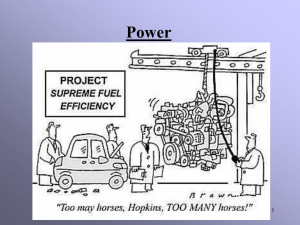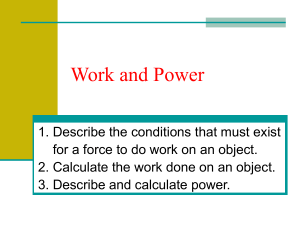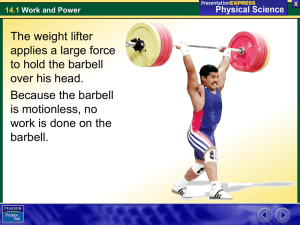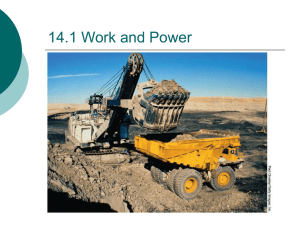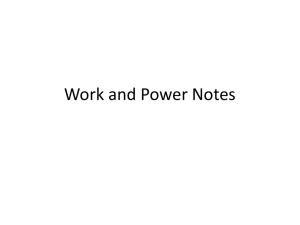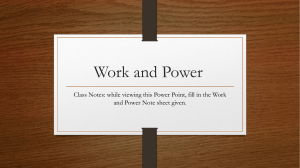•The weight lifter applies a large force to hold the barbell
advertisement
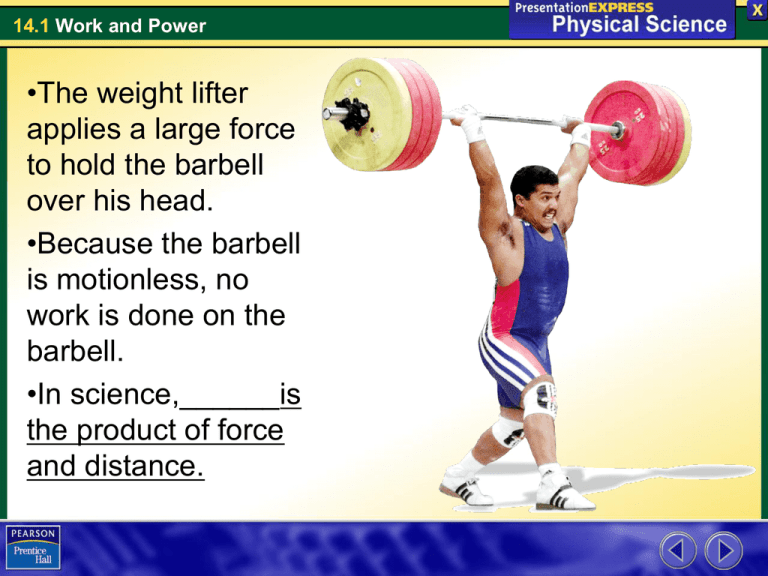
14.1 Work and Power •The weight lifter applies a large force to hold the barbell over his head. •Because the barbell is motionless, no work is done on the barbell. •In science,______is the product of force and distance. 14.1 Work and Power What Is Work? •Work is done when a force acts on an object in the ____________________the object moves. •Some of the force must act in the same direction as the object moves. •If there is no movement, no work is done. •Work is done when the weightlifter exerts an upward force to raise the barbell. •Work Requires _____________ •The weight lifter does no work on the barbell as he holds it over his head. The force applied to the barbell does not cause it to move. 14.1 Work and Power What Is Work? Work Depends on _________________ • If all of the force acts in the same direction as the motion, all of the force does work. • If part of the applied force acts in the direction of motion, that part of the force does ___________. • If none of the force is applied in the direction of the motion, the force does no work. 14.1 Work and Power What Is Work? A. All of the force does work on the suitcase. B. The horizontal part of the force does work. C. The force does no work on the suitcase. Force Direction of motion Force and motion in the same direction This force does work This force does no work Direction of motion Part of force in direction of motion Force Direction of motion Lifting force not in direction of motion 14.1 Work and Power Calculating Work Units of Work •When using SI units in the work formula, the force is in newtons, and distance is in meters. •The______(J) is the SI unit of work. A joule is equal to 1 newton-meter. 14.1 Work and Power Calculating Work Using the Work Formula A weight lifter raises a 1600-newton barbell to a height of 2.0 meters. • Work = Force × Distance • Work = 1600 N × 2.0 m • Work = 3200 N·m = 3200 J 14.1 Work and Power What Is Power? •Power is the___________of doing work. •Doing work at a faster rate requires more power. •Work is required to move snow from one location to another. •A person using a shovel and a person using a snow blower can both do the work needed to remove the snow. •The snow blower can do the job much faster because it has more power. 14.1 Work and Power What Is Power? Because the snow blower can remove more snow in less time, it requires more power than hand shoveling does. 14.1 Work and Power Calculating Power •When using SI units in the power formula, work is measured in joules (J), and time is measured in seconds (s). •The SI unit of power is the______(W), which is equal to one joule per second. 14.1 Work and Power Calculating Power 1. Your family is moving to a new apartment. While lifting a box 1.5 m straight up to put it on a truck, you exert an upward force of 200 N for 1.0 s. How much power is required to do this? Answer: Work = Force × Distance = 200 N × 1.5 m = 300 J Power = Work/Time = 300 J/1.0 s = 300 W 14.1 Work and Power Calculating Power 2. You lift a book from the floor to a bookshelf 1.0 m above the ground. How much power is used if the upward force is 15.0 N and you do the work in 2.0 s? Answer: Work = Force × Distance = 15 N × 1.0 m = 15 J Power = Work/Time = 15 J/2.0 s = 7.5 W 14.1 Work and Power Calculating Power 3. You apply a horizontal force of 10.0 N to pull a wheeled suitcase at a constant speed of 0.5 m/s across flat ground. How much power is used? (Hint: The suitcase moves 0.5 m/s. Consider how much work the force does each second and how work is related to power.) Answer: Work = Force × Distance = 10.0 N × 0.5 m = 5 J Power = Work/Time = 5 J/1.0 s = 5 W 14.1 Work and Power James Watt and Horsepower •Another common unit of power is the horsepower. •One_____________(hp) is equal to about 746 watts. •________Watt (1736-1819) was looking for a way to compare the power outputs of steam engines he had designed. Horses were a logical choice for comparison as they were the most commonly used source of power in the 1700s. 14.1 Work and Power James Watt and Horsepower The horse-drawn plow and the gasolinepowered engine are both capable of doing work at a rate of four horsepower.

